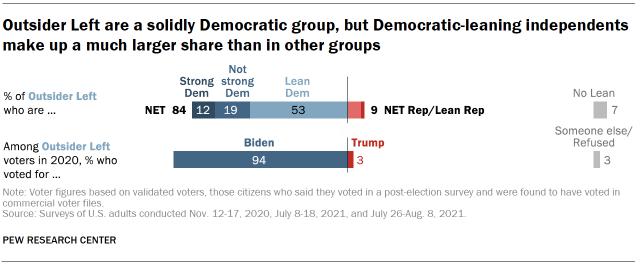Young, liberal, discontented Democrats
Outsider Left are the youngest typology group, making up 10% of the public. Holding liberal views on most issues and overwhelmingly voting Democratic, they aren’t particularly enamored with the Democratic Party – though they have deeply negative views of the GOP.
Nearly half of Outsider Left (48%) describe their own political views as liberal, including 20% who say their views are very liberal. But despite their liberal tilt, only about three-in-ten identify as Democrats; about half (53%) instead say they are independents who lean toward the Democratic Party.
Like Progressive Left, Outsider Left hold liberal views on most social issues, and particularly on issues of racial and ethnic equality and on immigration. Outsider Left are somewhat more skeptical of government’s role than other Democratic-oriented groups, though far less so than those in GOP-oriented groups.
Weaker attachment to the Democratic Party than other Democratic-leaning groups does not translate into positive attitudes toward Republicans among Outsider Left: Three-quarters say they feel very coldly toward Donald Trump, and just 13% say the Republican Party represents them very or somewhat well.
Political affiliation, voting and engagement
Outsider Left don’t feel very warmly toward the Democratic Party, despite the large share who lean in its direction and the overwhelming share who vote Democratic. On a “feeling thermometer” ranging from 0-100, where 100 represents the warmest, most positive feelings, Outsider Left give Democrats an average rating of 52, indicating feelings that are almost perfectly neutral. And they are significantly colder toward Republicans, giving them an average rating of 27.
Outsider Left were – along with Progressive Left – the most likely to back Sen. Bernie Sanders in the 2020 Democratic primaries. Nearly four-in-ten (38%) supported Sanders in January 2020, compared with 18% who supported Sen. Elizabeth Warren and just 12% who backed Joe Biden.
This group remains relatively cool on Biden when compared with other Democratic-oriented groups today. While a September survey found a majority (62%) approving of the president’s job performance, the share who say this is smaller than in each of the three other Democratic-oriented groups.
Outsider Left, like Stressed Sideliners and Ambivalent Right, are less politically engaged than other typology groups. Eligible Outsider Left were 9 percentage points less likely to vote in the 2020 presidential election than the average adult citizen and 11 points less likely to vote than the average Democrat or Democratic-leaning citizen. Only about two-in-ten (21%) say they follow what’s going on in government and politics most of the time.
Outsider Left: Key political attitudes and beliefs
More than nine-in-ten Outsider Left (94%) say that the economic system in this country unfairly favors powerful interests. Nearly half in this group (48%) say that government is almost always wasteful and inefficient, higher than in other Democratic-leaning groups. They are dissatisfied with national conditions: Just 26% say they are satisfied with the way things are going in the country, which is lower than other Democratic-aligned groups except Progressive Left.
Roughly six-in-ten (63%) say that there are other countries that are better than the United States, one of only two groups in which a majority says this (majorities in other groups say the U.S. is either among a small number of the greatest countries in the world or say the U.S. stands above all other countries).
To some degree reflecting the relative youth of this group, there is widespread support for making tuition at public colleges and universities free for all American students. Outsider Left are also very liberal on issues related to race and immigration. In addition, 41% favor cutting spending on local police, similar only to Progressive Left, and 54% say that the number of legal immigrants admitted to the U.S. should increase.
Outsider Left don’t feel quite at home in the Democratic Party
Although their political values place them decidedly on the left of the political spectrum, and they overwhelmingly vote Democratic when facing a choice between Democratic and Republican candidates, Outsider Left don’t feel particularly well-represented by the Democratic Party. Just 53% say the Democratic Party represents them at least somewhat well – eight-in-ten or more in other Democratic-oriented groups say this. And an overwhelming majority (86%) say that they usually feel like none of the candidates for public office represent their views well.
Outsider Left also are the typology group least likely to say there are substantial distinctions between the two parties: Just 23% say there is a great deal of difference between what the Democratic and Republican parties stand for.
Registered voters in the Outsider Left are much less likely to say it really matters which party wins control of Congress next year than those in most other political typology groups.
Outsider Left: Who they are
Outsider Left are by far the youngest political typology group. Four-in-ten are under the age of 30 and 83% are under 50. They are racially and ethnically diverse: About half (49%) are White, 20% are Hispanic, 15% are Black and 10% are Asian. Women make up 57% of this group.
Outsider Left also have somewhat less formal education than Establishment Liberals or the Progressive Left: 35% have at least a college degree. Two-in-ten members of this group are either full-time (14%) or part-time (6%) students, similar to the share of students in the Progressive Left and higher than the shares in any other group.
About half of Outsider Left (55%) say that their personal finances are in only fair or poor shape, a somewhat higher share than the public as a whole. However, nearly half (48%) expect their financial situation to be better a year from now, compared with 36% of the public who say this.
Outsider Left are one of the least religiously affiliated groups, alongside the Progressive Left. About half (51%) are religiously unaffiliated. Outsider Left are less likely to attend religious services regularly or say that practicing their religion is one of the most important things in their lives compared with all U.S. adults.








